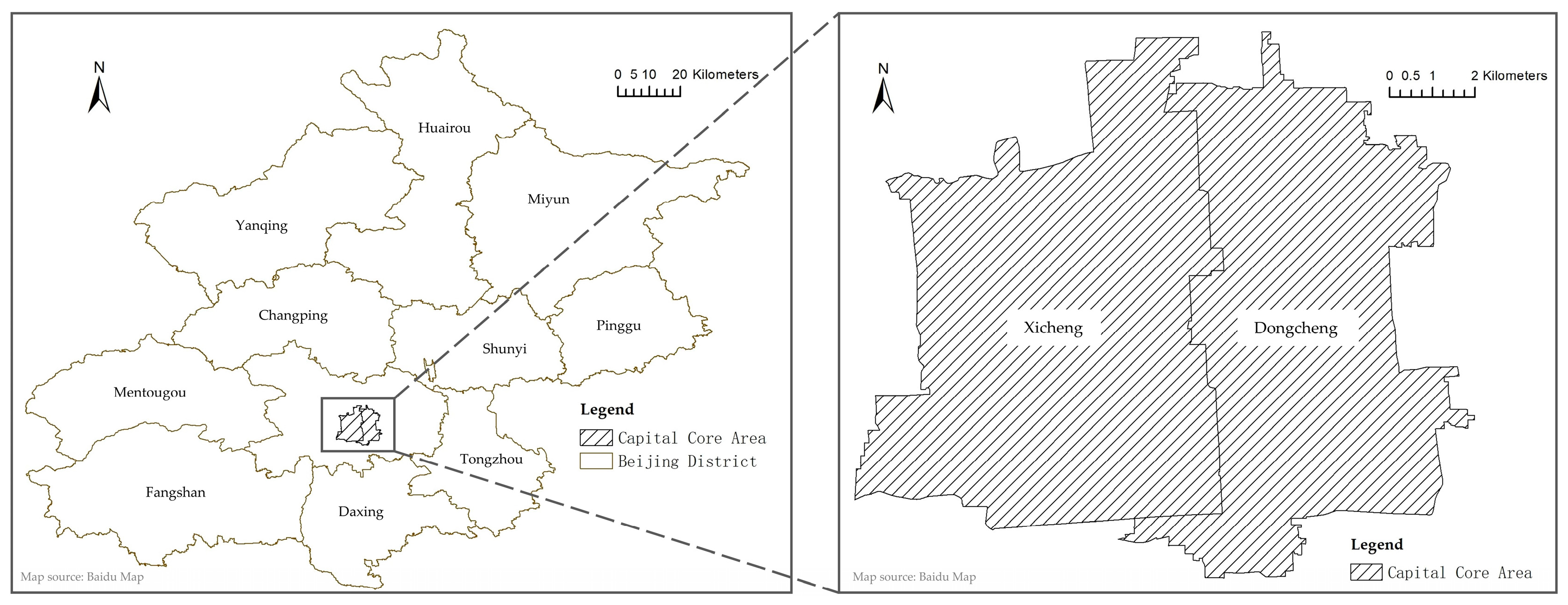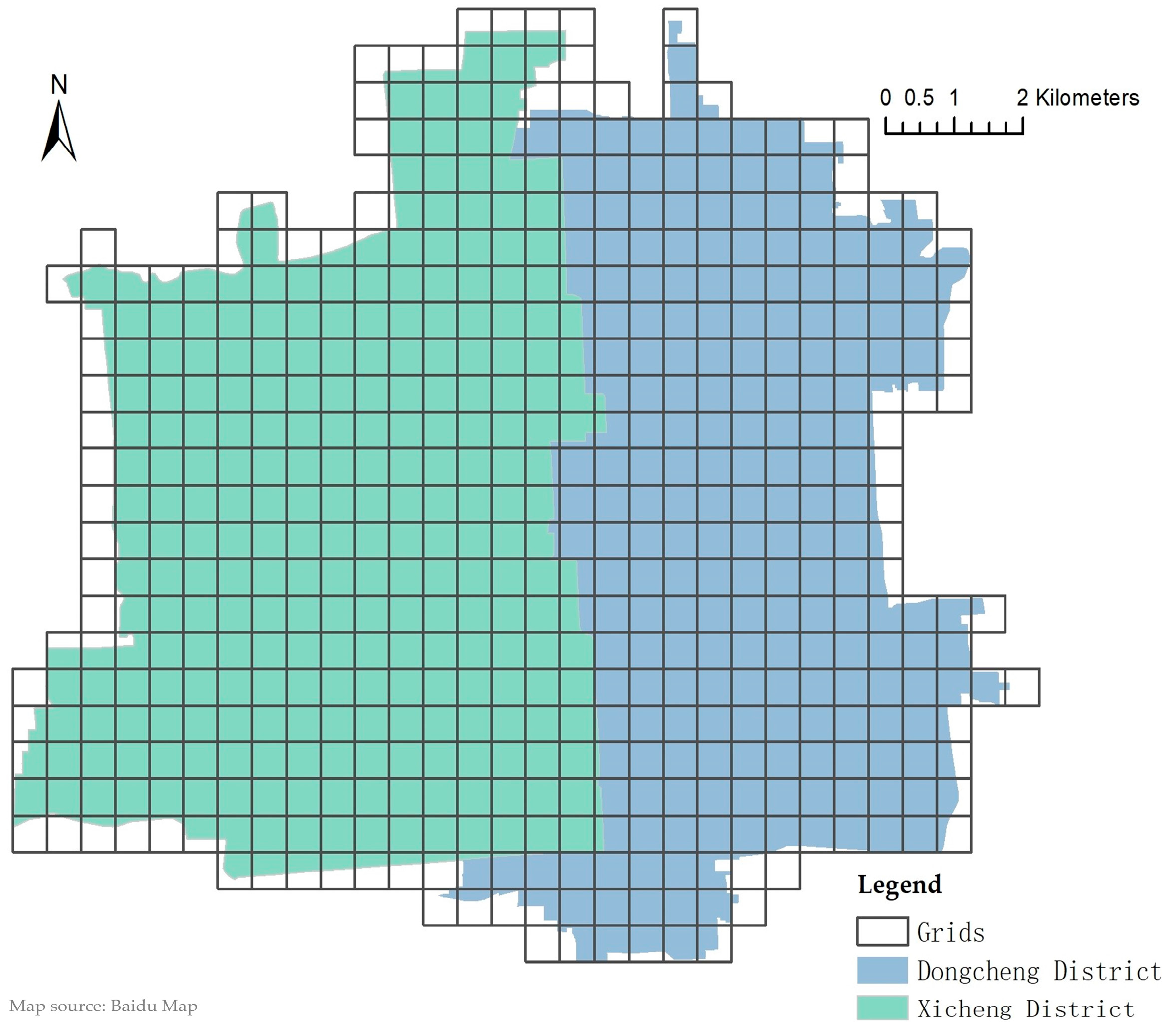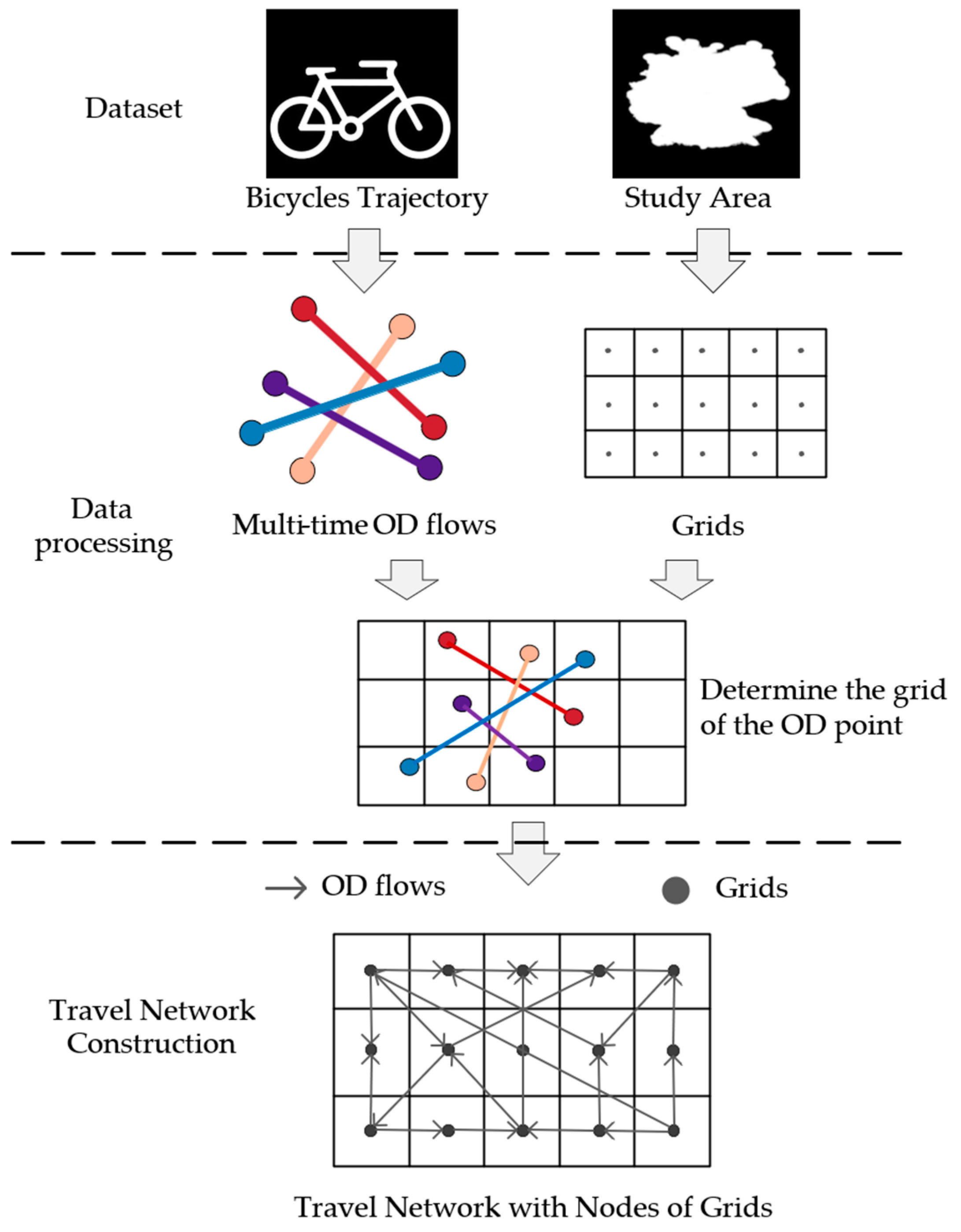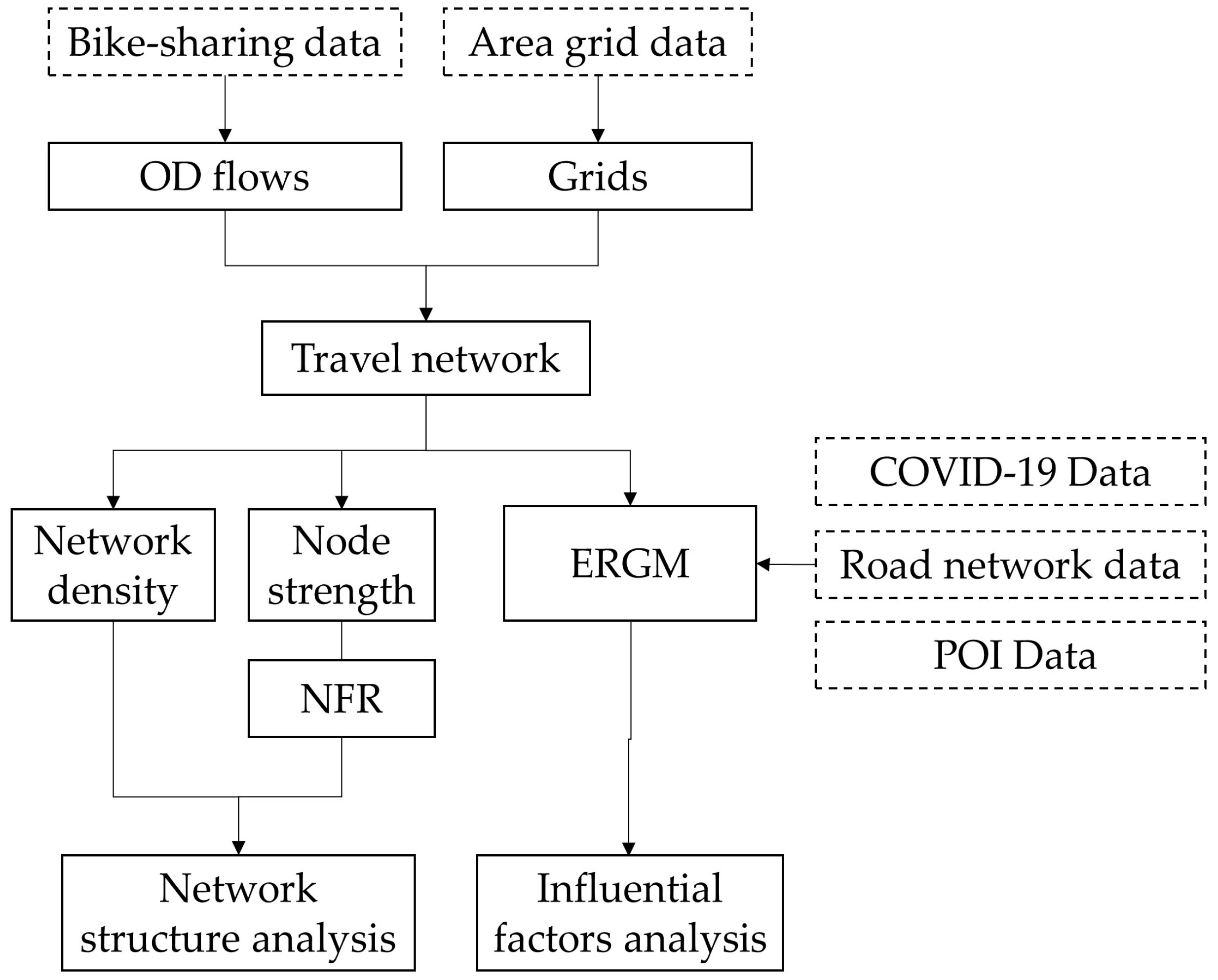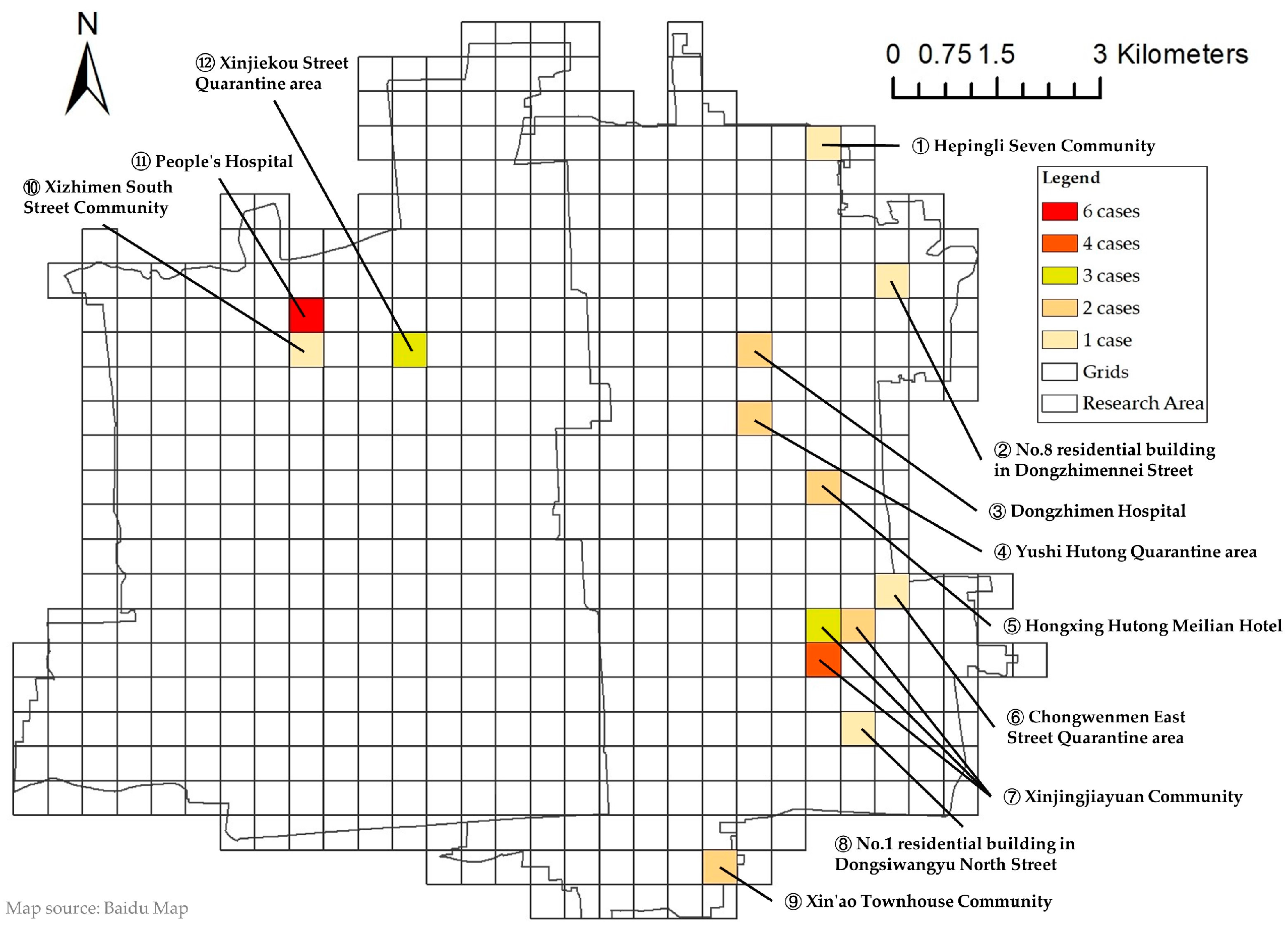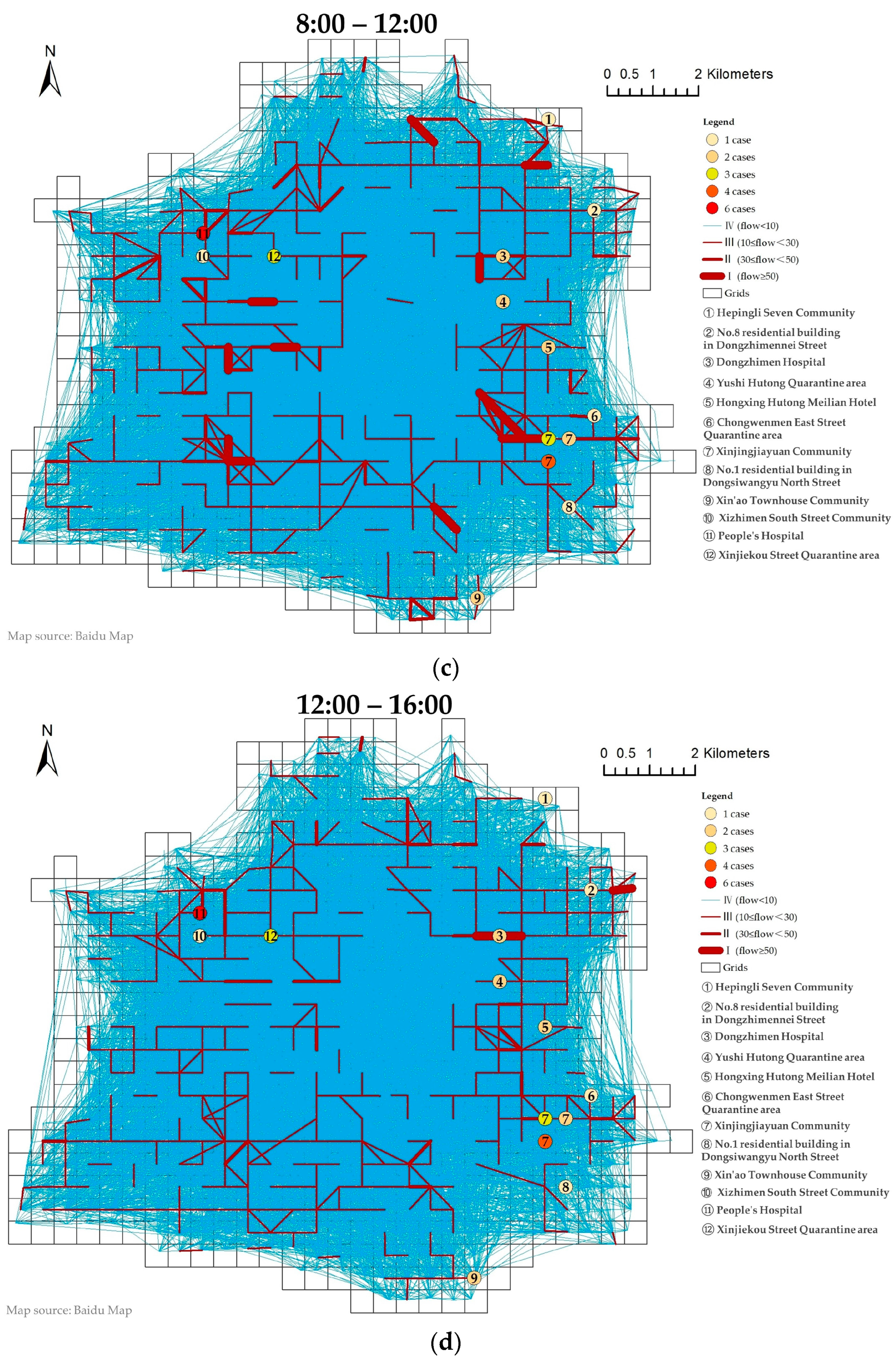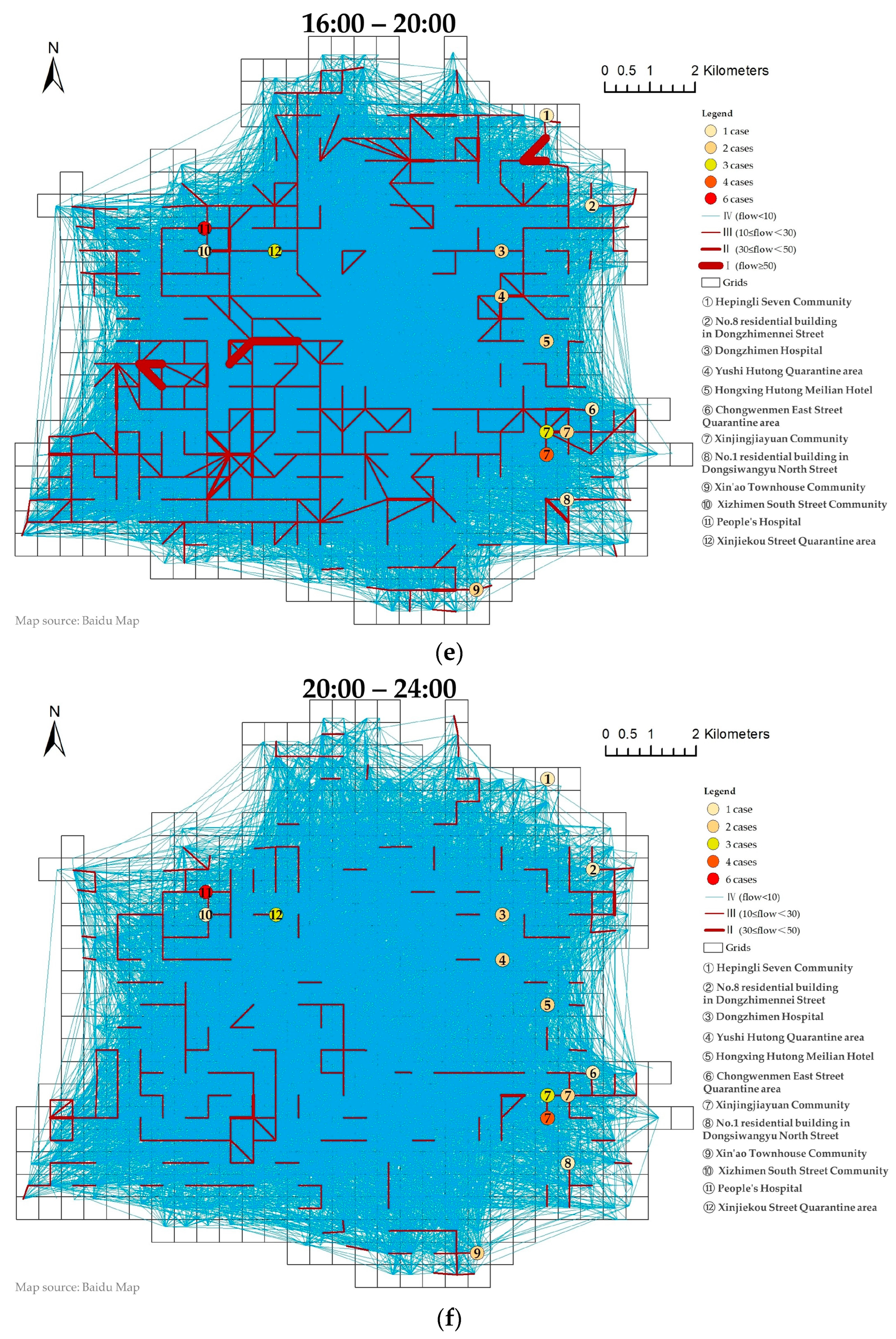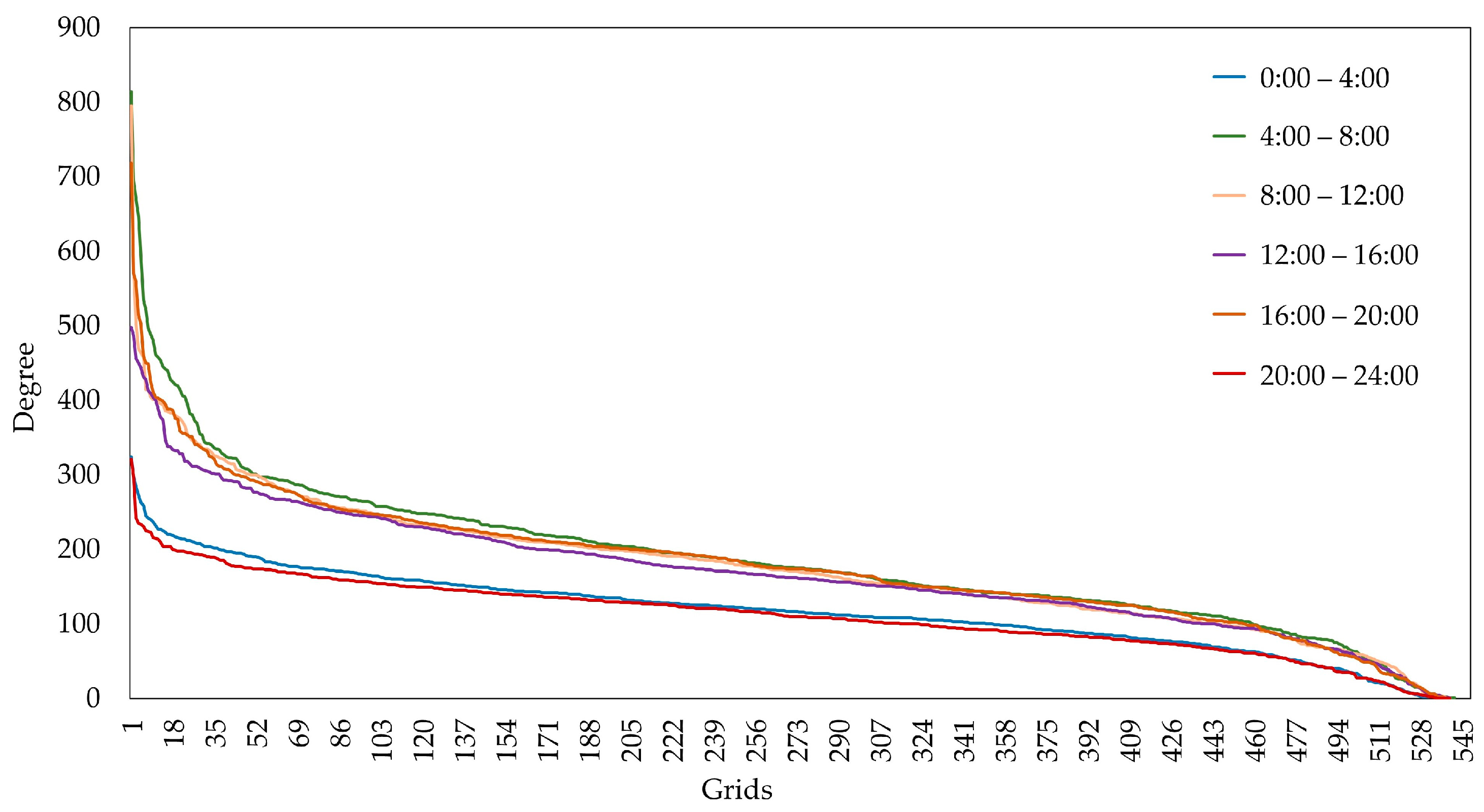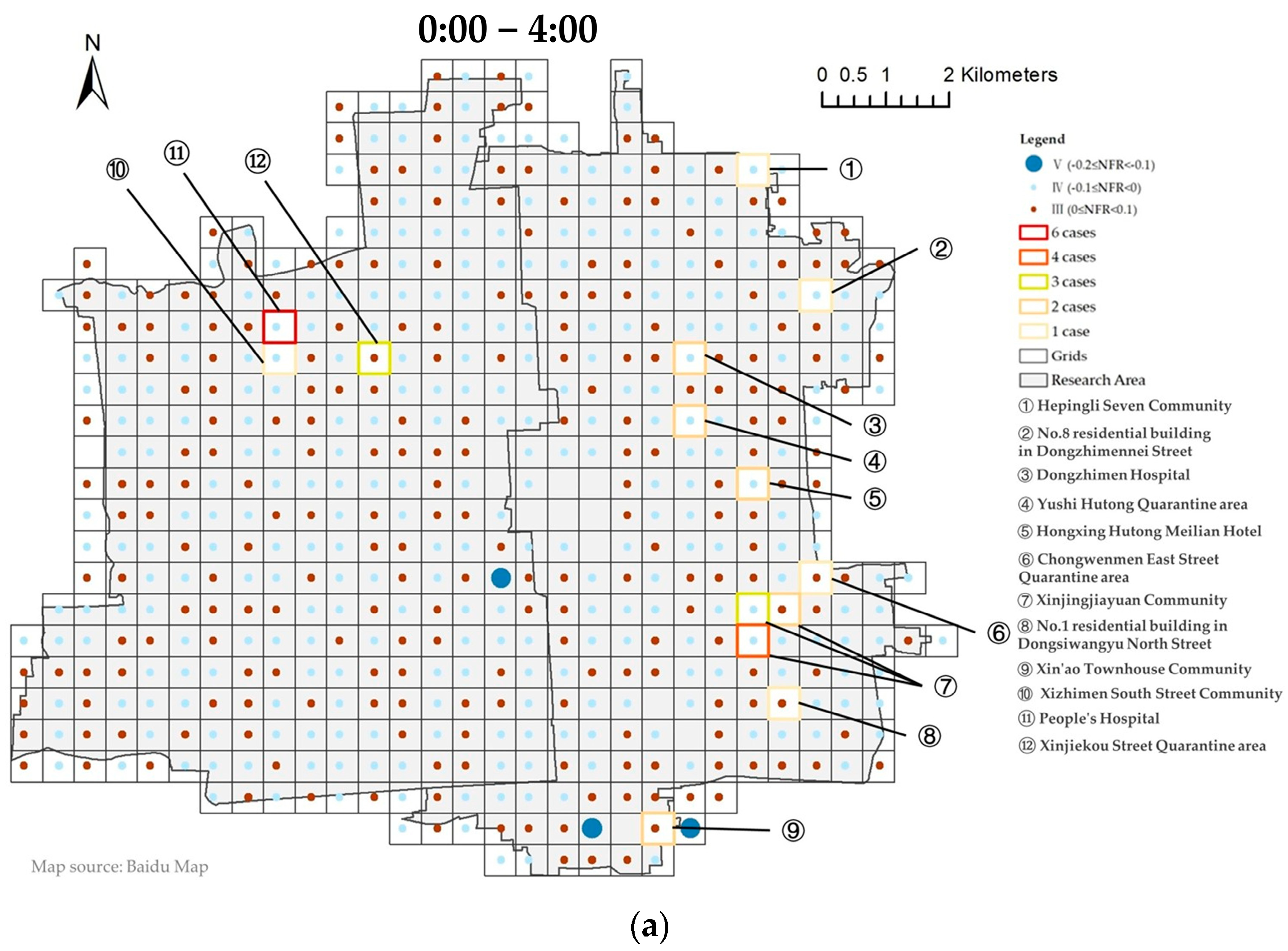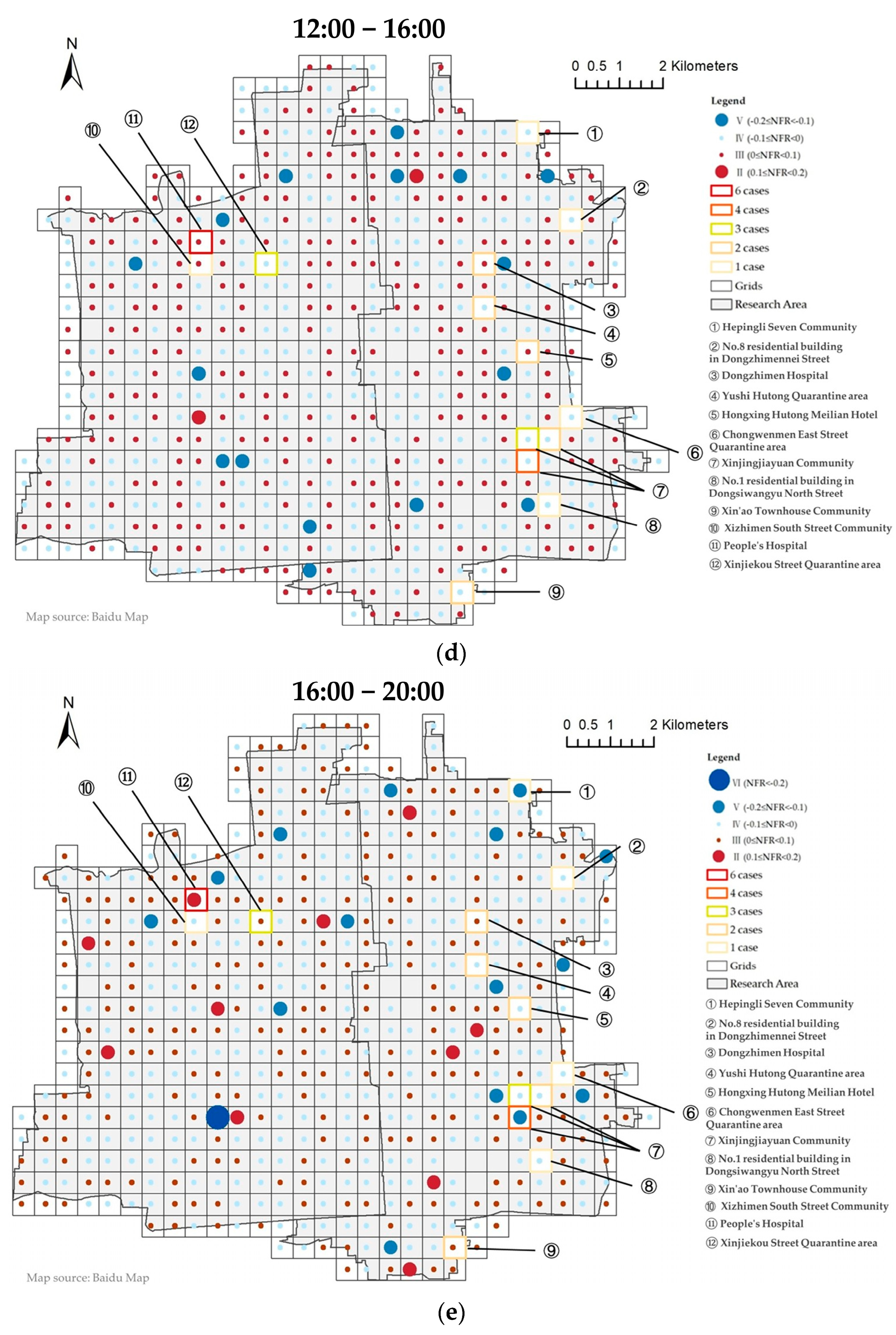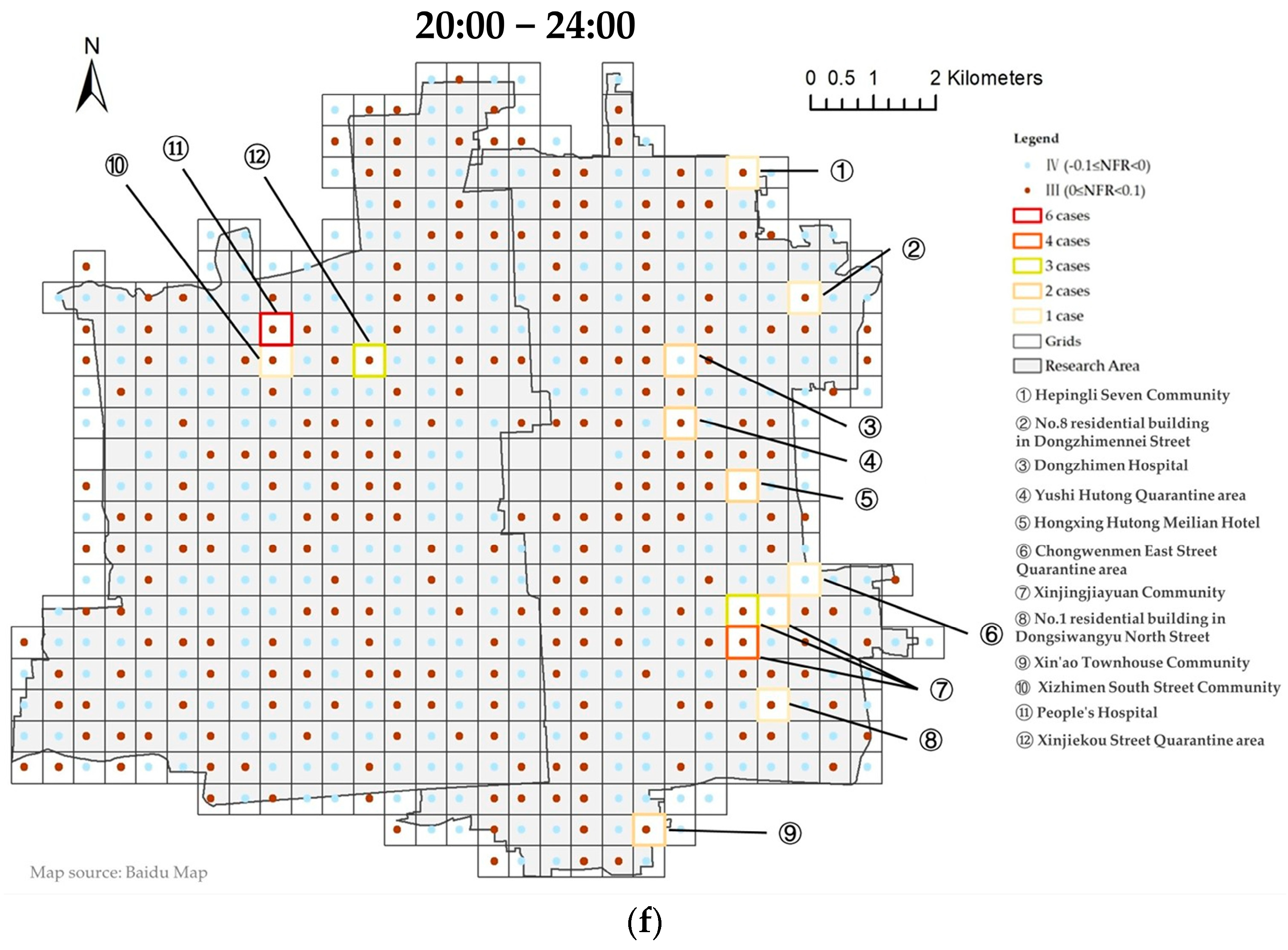1. Introduction
The emergence of public health emergencies has exerted a profound influence on various domains, including society, geopolitics, the environment, climate, and the economy [
1,
2]. Using the COVID-19 pandemic as a case study, since the initial confirmation of cases in Wuhan in December 2019, numerous cities have instituted appropriate containment and control measures. Policies, such as face masks and social distancing mandates, closure of schools and non-essential businesses, and work-from-home protocols, have significantly altered the way many citizens live [
3]. Personal travel stands out as a primary contributor to the community spread of the pandemic [
4], and it has experienced considerable disruption [
5]. Individuals were compelled to reassess their travel preferences and make transportation decisions accordingly [
6]. Amid the pandemic, urban dwellers shifted away from traditional public transportation modes like subways or buses [
7]. Conversely, bike-sharing, as an emerging active mobility mode [
8,
9], coupled with its “internet + sharing” feature [
10,
11], has gained popularity among residents. Simultaneously, bicycle-sharing systems (BSS) have proven effective in mitigating various transportation and environmental challenges, including traffic congestion [
12], air pollution [
13], and carbon emissions. Enhancing accessibility and boosting public transport patronage are crucial in this regard [
14,
15]. The improvement of bicycling accessibility has emerged as a key strategy for addressing the rebalancing issue in BSS during the pandemic [
16,
17]. Consequently, numerous contemporary studies have delved into the analysis of methods for enhancing bike-sharing systems [
18,
19]. In response to the COVID-19 pandemic, bike-sharing systems emerged as a safer alternative to traditional public transport modes, offering an option to reduce the risk of infection while providing efficient urban mobility. This shift highlights the adaptability of bike-sharing systems in times of public health crises.
With bike-sharing, the flow of crowds is generated among various areas in the city [
20]. Therefore, it becomes an integral component of BSS research to investigate the spatial patterns of bike-sharing crowd flows and the primary determinants of residents’ bike-sharing usage. The findings from these studies can aid decision-makers in planning relevant transport infrastructure and assist operators in addressing issues related to bicycle imbalance [
21]. Prior to the COVID-19 pandemic, numerous researchers had conducted extensive studies on the factors influencing bicycle sharing. It has been observed that the probability of bike-sharing usage increases depending on the distance between stops and their familiar destinations in Canada [
22]. Furthermore, studies have demonstrated not only a significant and positive association between the number of cafes and restaurants and the frequency of bike-sharing trips [
23], but also a correlation with the number of residential, commercial, and parkland areas in southern European island cities [
24]. The distribution of BSS infrastructure and transportation infrastructure has been identified to impact bike-sharing demand in New York [
25]. In Shanghai, China, the influence of temperature and precipitation on the demand for bike-sharing rides is substantial [
26]. In Beijing, dedicated bike lanes, street lights, sidewalks, and bike parking were found to significantly impact bike-sharing demand [
27]. At train stops, determinants of bike-sharing demand include passenger flow at bus stops, land use, bus lines, and road-network characteristics [
28]. On college campuses, campus characteristics serve as primary determinants of bike-sharing demand, encompassing faculty size, student population, school size, vacations, semesters, and temporal factors related to student flow and weather [
29]. Different land uses, such as residential, employment, recreation, and metro stops, have been identified as crucial influencing factors [
30].
In addition to the aforementioned factors, an increasing number of researchers are directing their attention to the impact of the COVID-19 pandemic [
31,
32]. Studies indicate that bike-sharing represents a more resilient option when compared to transit, driving, and walking [
33]. Amid the COVID-19 pandemic, individuals are more inclined to opt for shared bikes as an alternative to traditional public transportation to mitigate the risk of infection [
34], given the perceived safety of personal transportation during an outbreak in contrast to public transportation [
35]. The substantial decrease in demand for taxis contributed to an upsurge in the demand for shared bicycles [
36]. Government policies enforcing social distancing measures in response to the epidemic also played a role in influencing the utilization of shared bicycles [
6]. However, some studies present contrasting results, suggesting that residents express concerns about the lack of disinfection of shared bicycles after use, leading to heightened fears of infection and a subsequent reduction in the use of shared bicycles [
37].
From a methodological standpoint, the majority of studies on bike-sharing determinants rely on regression models, encompassing negative binomial regression models [
21], binary logistic regression models [
22], bivariate correlation analysis [
23], linear mixed models [
27], and multilevel regression analysis [
30]. Additionally, spatial auto-regressive (SAR) models [
24], spatial error and spatial lag models, spatiotemporal Bayesian modeling methods, and geographically weighted regression (GWR) models have been employed [
28]. However, while these methods allow for both qualitative and quantitative analysis of the effects of various factors, they do not consider the impact on the interactions between regions when considering regional properties as factors [
14]. Inter-regional crowd flows give rise to corresponding network structures in space. Moreover, as trips exhibit directional and flow distinctions, the travel activities of bike-sharing between intra-city regions form a weighted directional network embedded in geographic space. Directed weighted networks can be studied as complex systems. Research shows that dockless bike-sharing travel patterns exhibit small-world and scale-free characteristics in multiple cities, with higher traffic node density in city centers [
38]. Other studies suggest that bike-sharing demand is higher during the morning and evening peak hours in large cities, and the connections between bike-sharing stations are more concentrated in city center areas. Additionally, the bike-sharing network shows positive spatial autocorrelation and distinct community structures [
39]. Therefore, network analysis metrics and statistical network models can be employed to investigate the travel characteristics of bike-sharing and its determinants. This study employs network analysis methods from complex network theory, using the Exponential Random Graph Model (ERGM) to analyze the usage patterns of the bike-sharing system. This approach captures the interdependencies of flows between regions and reveals the spatial dynamics underlying bike-sharing movement patterns.
In terms of the temporal scale for bike-sharing analysis, the majority of existing research focuses on a day or more extended periods, such as days, weeks, and months [
20,
21,
22,
23,
25,
26,
27]. Only a relatively small portion of the literature utilizes a finer temporal scale, specifically moments of the day [
24]. Examining and studying within a single day can enhance conclusions drawn from different temporal scales and address the specific challenges related to BSS imbalances on a daily basis. Moreover, the study area of Beijing is a first-tier city with a resident population exceeding 20 million. Beijing’s BSS has experienced substantial growth since 2014, boasting 2777 public bicycle outlets, 200,000 daily rentals and returns, and 941,000 shared bicycles. Given the significant temporal variations in the demand for shared bicycles in Beijing, especially in the core area, and the frequent occurrence of supply–demand imbalances, research on shared bicycle travel during multiple periods of a day becomes imperative.
While numerous studies have analyzed shared bike data, this research distinguishes itself by focusing specifically on the impact of the COVID-19 pandemic on bike-sharing patterns, offering a unique perspective on how public health emergencies reshape urban mobility. The primary objective of this study is to investigate how the pandemic has influenced bike-sharing travel patterns, including demand distribution, travel characteristics, and network structures. Unlike traditional regression-based approaches, we employ a network-based framework to analyze bike-sharing travel patterns, providing a more comprehensive understanding of the spatial interactions between urban areas. Additionally, we examine bike-sharing usage across multiple time periods within a single day, capturing the dynamic nature of demand variations. This study integrates a variety of influencing factors, such as road network density, COVID-19 cases, and points of interest (POIs), using the Exponential Random Graph Model (ERGM) to evaluate the relative importance of each factor in shaping bike-sharing patterns during the pandemic.
In summary, this paper addresses three key objectives. First, it investigates the spatial characteristics of shared bicycle trips during weekdays using network models. Second, it explores the spatial characteristics and influencing factors of shared bicycle travel at different times of the day during the pandemic. Lastly, it examines the impact of COVID-19 on shared bike travel distribution and its determinants. To achieve these goals, this paper aims to: (i) construct weekday shared bicycle travel networks and analyze their network characteristics; (ii) use the Exponential Random Graph Model (ERGM) to integrate both network structure variables and node attribute variables, exploring the factors influencing bike-sharing across different periods and assessing their impact during the pandemic; (iii) analyze the distribution of COVID-19 as one of the key influencing factors to provide a comprehensive understanding of the travel network.
This paper is organized as follows:
Section 2 introduces the research area, data sources, principles of network construction, and indicators of the network model;
Section 3 conducts experiments to statistically analyze the network structure and influencing factors of bike-sharing within the study area;
Section 4 and
Section 5 presents conclusions and discussions.
4. Discussion
Based on bike-sharing data, this study investigated the spatial and temporal variations of travel networks in Beijing’s core area during the COVID-19 pandemic, with a particular focus on weekdays. By utilizing network structure indicators, we analyzed the travel characteristics of bike-sharing and applied the Exponential Random Graph Model (ERGM) to explore the factors influencing the formation of urban bike-sharing travel networks during the pandemic. Our findings emphasize the significant impact of COVID-19 on bike-sharing usage patterns, especially in areas with high infection rates. The main findings and their implications for urban mobility planning are as follows.
(i) The analysis reveals that bike-sharing is predominantly used for short-distance travel, with most trips occurring between adjacent grids. The travel patterns exhibit distinct temporal variations, divided into daytime (4:00–20:00) and nighttime (0:00–4:00 and 20:00–24:00) periods. Daytime travel is characterized by higher total trip volumes, broader usage ranges, and greater traffic concentration compared to nighttime. Specifically, 4:00–8:00 represents the morning peak, with the most concentrated traffic, followed by 8:00–12:00, where commuting continues. The period from 12:00 to 16:00 serves as a transition phase, while 16:00–20:00 marks the evening peak, the most active period for bike-sharing, with residents engaging in diverse travel purposes such as leisure and dining. Notably, bike-sharing maintains a consistent level of activity throughout the daytime, without significant peaks or valleys, reflecting the high population density and continuous urban mobility in Beijing’s core area. (ii) The node intensity distribution follows a power-law distribution, indicating that the travel network exhibits scale-free properties, a hallmark of complex networks. Node intensity is significantly higher during the daytime than at night. Within the daytime, 4:00–8:00 records the highest node intensity, while 12:00–16:00 has the lowest. The NFR analysis further reveals that 4:00–8:00 is the most concentrated period, with a dominant decrease in node heat, reflecting residents leaving residential areas for work or transit hubs. In contrast, 8:00–12:00 shows a balanced increase and decrease in heat, indicating sustained commuting activity. The evening peak (16:00–20:00) is more dispersed, with residents traveling for varied purposes, such as leisure and dining, rather than returning directly home. Nighttime periods exhibit minimal heat variation and lower trip volumes, likely due to reduced activity and bike rebalancing operations. (iii) The network structure, node strength, and NFR analysis indicate that bike-sharing usage in areas with confirmed COVID-19 cases is generally lower than in unaffected areas, likely due to reduced mobility and fear of infection. However, the presence of hospitals and train stations increases travel activity in pandemic-affected areas, as these locations remain essential for commuting and medical purposes. This highlights the dual role of bike-sharing during the pandemic: as a safer alternative to public transport and a critical mode of travel for essential activities. (iv) The ERGM results reveal that mutual connections (Mutual) have a significant positive effect, indicating a high likelihood of bidirectional interactions between node pairs. The road network (Rnet) is the most influential factor, with a strong negative impact on bike-sharing trips, suggesting that complex road layouts may deter bike usage. Conversely, the COVID-19 pandemic (Covid) has the most substantial positive influence during the daytime, as residents opt for bike-sharing to avoid public transport and reduce infection risks. Transportation stops (Tsta) and educational institutions (Edu) also play significant roles, with positive coefficients throughout the day, reflecting their importance as key destinations. Transportation facilities and financial services further boost bike-sharing during the daytime, while dining (Din) and shopping (Shop) have smaller effects. Dining establishments only facilitate trips during 8:00–12:00, likely due to lunch-related travel, but negatively impact bike-sharing at other times. Shopping establishments have a minor effect during the day but slightly higher activity at night, possibly due to leisure shopping.
These findings provide valuable insights into the dynamics of bike-sharing during public health emergencies, offering practical implications for urban transportation planning and bike-sharing system management. This study underscores the importance of optimizing bike allocation, enhancing infrastructure near key destinations, and addressing the unique challenges posed by pandemics to ensure sustainable urban mobility.
5. Conclusions
This study offers valuable insights into the dynamics of urban bike-sharing travel networks during the COVID-19 pandemic in Beijing. The key findings highlight the short-distance travel nature of bike-sharing, the significant impact of the COVID-19 pandemic on travel patterns, and the crucial role of transportation infrastructure, such as hospitals, train stations, and educational institutions, in shaping travel behavior. The Exponential Random Graph Model (ERGM) has proven essential in identifying the various factors influencing the formation and evolution of travel networks during the pandemic.
These findings have important practical implications for urban traffic management and bike-sharing operators, emphasizing the need for strategic adjustments in bike distribution, infrastructure, and scheduling to better align with shifting travel demand patterns during the pandemic. Specifically, bikes should be deployed more intensively in areas with high travel demand during peak periods and in locations with COVID-19 cases to mitigate infection risks. Future research should consider comparative analyses with alternative modeling approaches, expand the range of influencing factors included in the analysis, and refine the methods for accurately identifying network nodes to improve the robustness of findings.
Despite its valuable insights, this study has certain limitations, such as the reliance on a single model (ERGM), the short data collection period, and the potential simplification of network nodes. Future research could address these limitations by incorporating additional models, expanding the time window, and refining the node identification methods. Such improvements will enhance the robustness of the findings and provide more effective recommendations for pandemic prevention and urban mobility management.
